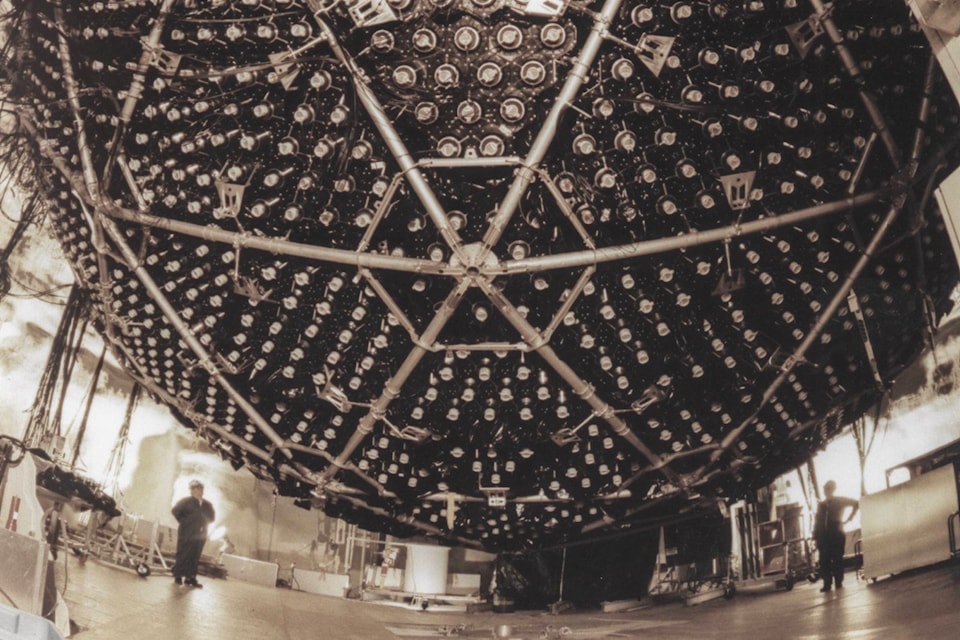We put our radio telescopes in valleys that screen them from man-made interference, but where there is a good view of the sky. Our optical telescopes get put in dark places, often on top of mountains, above the part of the atmosphere that makes the images shimmer, and of course, once again with a good view of the sky.
It, therefore, sounds counterintuitive to put astronomical instruments underground, usually as far down as possible, or deep in the Arctic or Antarctic ice. We have also put instruments in the deep ocean.
As we move around in our daily lives, huge numbers of high-energy particles are sleeting through us, producing no noticeable effect, and doing us no harm.
These particles are called neutrinos since they have no electrical charge. They also have almost no mass and travel close to the speed of light. Since they pass through matter as though it does not exist, it is very hard to make anything that can detect them. However, on very rare occasions a neutrino does interact with an atom. In this case, “rare” means one in 1E36 (one followed by 36 zeros) neutrinos passing through the Earth may actually hit something. When this happens, the result is a tiny flash of light. Considering their extreme elusiveness, why bother trying to observe neutrinos at all?
Actually, the reason we want to do this is also the reason they are hard to detect; they pass through anything and are almost totally unaffected. For example, they provide the only direct way we can look into the core of the sun and other stars. The energy produced in a star’s core has a long, circuitous trip to the surface of the star (its photosphere) before being radiated into space. It gets passed from one atom to another so that after bouncing from atom to atom for around 200,000 years, it radiates off into space. By that time it carries very little information about the processes that produced it, or even perhaps whether that energy process has changed. However, energy production in stars also produces neutrinos. These escape from the star with no problem at all, so that when we observe them, we are seeing things produced mere minutes ago. There are other high-energy processes taking place in space which produce neutrinos; these include supernova explosions and things taking place close to black holes. If we have a scientific need to detect them, how can we do that?
Typically we want a huge number of atoms, with detectors watching them to pick up those faint flashes produced when a neutrino gets caught. A really huge volume of clear liquid or solid, surrounded by detectors would do the job. For example, the Sudbury Neutrino Observatory, located 2.1 kilometres underground in a mine near Sudbury, Ont., consists of a big spherical tank containing over 1000 tonnes of heavy water, with the inside wall covered with around 9600 light sensors. Other neutrino detectors consist of arrays of sensors buried in ice, or at the bottom of the sea. We have to put our neutrino telescopes far underground, under ice or underwater to block out the other particles arriving from space. Even then, our preferred observing direction is downwards, through the rest of the thickness of the Earth. Anything managing to reach the detector through the diameter of the Earth will almost certainly be a neutrino. Moreover, the light flash can tell us the direction in which the neutrino is moving. These elusive particles are proving to be a powerful tool for studying places we cannot observe in any other way. It is intriguing to consider that we make these observations from deep under the ground, ocean, or ice caps, looking downward.
Look for Mars low in the predawn glow and Jupiter and Venus low in the southwest in the post-sunset glow. Saturn is low in the southwest after sunset. The moon reaches last quarter on Nov. 19 and will be new on Nov. 26.
Ken Tapping is an astronomer with the Dominion Radio Astrophysical Observatory near Penticton. Email: ken.tapping@nrc-cnrc.gc.ca
